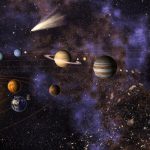Key takeaways
- Jupiter both protected Earth by deflecting debris and possibly delivered water-rich materials to the rocky planets during the early solar system.
- Gas giants like Jupiter may have shepherded water-rich debris from the outer solar system to inner rocky planets, crucial for forming habitable worlds.
- Recent simulations suggest that gas giants’ formation and movements could send hydrogen-rich materials to Earth’s crust and mantle, later forming water.
- The Nice model and Grand Tack model describe the movements of gas giants, explaining their role in distributing water-rich materials in the early solar system.
- Systems with gas giants and rocky planets are likely to have water-rich inner planets, expanding the potential for finding habitable exoplanets.
Jupiter has a questionable history in our solar system’s early days. In other ways, the giant protected Earth by throwing dangerous debris away from the rocky planets with its gravity. At the same time, Jupiter may have flung material inward, crushing hydrogen-rich asteroids and planetary embryos, or planetesimals, onto densely packed nascent terrestrial planets.
Researchers now believe that by doing so, Jupiter and other gas giants may have provided something else essential to rocky worlds: water.
The most massive planets may have shepherded water-rich debris from the outer solar system to the rocky planets. And recent research reveals that the liquid’s delivery, a critical component of life as we know it, may not have been by chance. Instead, any planetary systems fortunate enough to have a gas giant on their outskirts should see water-rich debris fall on their rocky inner planets.
After the gas giants have fully grown, the debris they throw inside can be hazardous. However, during a critical stage of their formation, they toss hydrogen-rich material into the Earth’s crust and mantle, where it eventually emerges to mix with oxygen and form water.
“In the process of formation, they send this big pile of planetesimals all over the place, and some bash into the terrestrial planets,” said Sean Raymond, an astronomer at France’s University of Bordeaux and main author of a research published in the journal Icarus. By simulating the role of gas giants in the early solar system, Raymond discovered that huge planets of varied sizes inexorably threw water-rich material into the inner system, where rocky worlds could potentially hold it as liquid water.
Water, of course, is an essential component for the evolution of life as we know it on Earth. So, when it comes to seeking worlds beyond the solar system, stony planets capable of harboring the valuable liquid are regarded to be the greatest hunting grounds for extraterrestrial life. Since the 1980s, scientists have battled to figure out how water got on Earth. Today, carbon-rich asteroids are the primary suspects.
Collisions were common in the early solar system, and orbits intersected, and early asteroids were still easily influenced by close encounters with other planets, whose gravity threw them toward rocky worlds.”I think it’s a very interesting story, and one that’s fundamental if you’re trying to understand how you make habitable planets,” Conel Alexander, who studies primitive meteorites from those asteroids, an astrochemist, explained.
The planets were created approximately 4.5 billion years ago in a cloud of gas left over from the formation of the sun. The gas lingered for millions of years, impacting the movement of the planets and their rock-rich components. Rising temperatures caused hydrogen, a building block for water, to become frozen in ice in the solar system’s frigid regions, far away from Earth.
It appeared like our planet was going to be an arid and barren wasteland. So, what happened?
‘A ridiculously basic concept’
In recent years, simulations of our solar system have revealed that the gas giants most likely performed a complex dance before landing in their current positions. Neptune and Uranus likely formed closer to the sun than they are now. They eventually migrated forth, switching places along the way. This mechanism, known as the Nice model, is assumed to have triggered the Late Heavy Bombardment, a surge of icy impacts approximately 600 million years after the solar system originated.
Saturn and Jupiter may have had an even more perilous journey, crashing through the juvenile asteroid belt on their way into the inner solar system before turning around and heading back out. Along the way, they sent asteroids falling into the Earth. This is known as the Grand Tack model, which Raymond helped develop in 2008.
Around that time, Raymond became interested in how Jupiter may have influenced water distribution in the early solar system. But his modeling was hampered by a tiny programming issue that he couldn’t manage to resolve. The problem was not solved until nearly a decade later, when postdoctoral researcher Andre Izidoro arrived.
“Izidoro found a bug I’d had for years in half an hour,” Raymond laments. “I was really happy that he found it so we could actually do the project.”
According to the new concept, when a gas giant expands and consumes more material, its gravity increases, destabilizing surrounding protoplanets. The pull of the still-present nebula gas influences how debris flows through the solar system, directing a portion of it inward into the inner solar system. Some of that material became locked in the asteroid belt, resulting in the formation of carbon-rich asteroids with water content equal to Earth’s.
Raymond claims that the carbon-rich asteroids were once spread in a zone ranging from 5 to 20 times the distance between Earth and the sun. “It must have covered the whole solar system,” he informs me.
But Alexander, who studies carbon-rich asteroids, believes the zone was smaller, with the majority of the suspects developing close beyond Jupiter’s orbit. Nonetheless, he believes Raymond’s concept does a decent job of describing how water-rich material got to Earth, calling the idea “perfectly reasonable.”
“This is the best way to get these volatiles into the terrestrial planet forming region,” the scientist claims.
The model leaves other concerns unanswered, including why so little of the early solar system’s abundance of mass remains now. “That’s a critical component that needs to be connected,” Raymond concedes.
Nonetheless, he claims that the model fills in other gaps, including why Earth’s water is more similar to the composition of asteroids in the outer belt than to those in the inner belts, which are dryer.
“It’s a ridiculously simple consequence of Jupiter and Saturn growing,” according to him.
Hunting water-rich worlds
Prior to Raymond’s hypothesis, academics believed that the peculiar dance of the outer planets was responsible for sending water into the inner solar system and preventing Earth from becoming a desert. If this were true, it would be bad news for other worlds, as the gas giants could have remained wallflowers, never moving far from where they began.
According to the new concept, any gas giant’s development would cause moist material to be hurled inward. While huge Jupiter-sized worlds were the most effective, Raymond discovered that any size gas giant may stimulate growth. That’s fantastic news for those looking for watery planets beyond our solar system.
In our own solar system, the model depicts ices from the outer solar system snowing down on Earth in three waves. The first appeared as Jupiter ballooned up. The second was triggered as Saturn formed. The third would have occurred when Uranus and Neptune migrated inward before being barred by the other two and relegated to the outer reaches of the solar system.
“I think the coolest thing is that it basically implies that in any exo-solar system where you have giant planets and terrestrial planets, those giant planets would send water inward to the terrestrial planets,” said David O’Brien, a Planetary Science Institute researcher who studies planet formation and the evolution of the early solar system. “That opens up a lot of possibilities for habitable planet studies.”
Unfortunately, there aren’t many similar systems to compare to right now. The majority of known exoplanets have been detected by NASA’s Kepler mission, which, according to O’Brien, is most sensitive to planets with narrower orbits than Earth and has difficulties discovering gas giants in the outer system. Smaller stony planets are also more difficult to view. That is not to say they aren’t there; it simply means we haven’t seen them yet.
However, if such systems exist, Raymond’s study predicts that the rocky worlds should be rich in what we call the liquid of life. “If there’s terrestrial planets and giant planets, those giant planets probably gave the terrestrial planet some water,” O’Brien points out.


